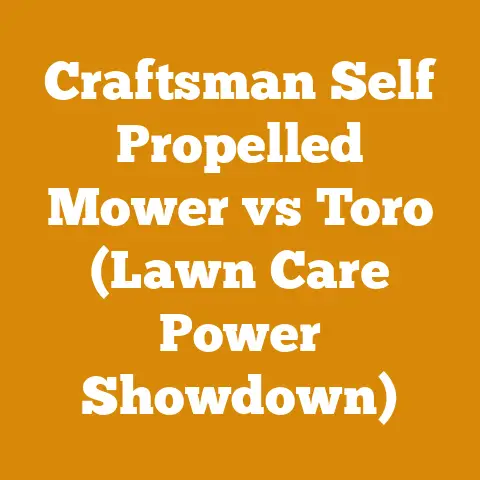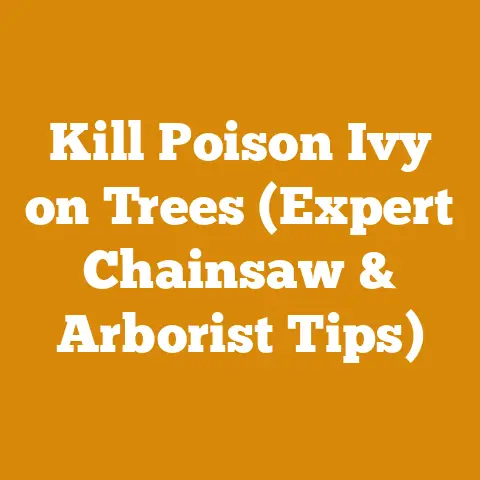Pesticide for Carpenter Bees: Wood Protection Tips (5 Pro Hacks)
Have you ever been enjoying the rustic charm of your wooden deck, only to notice perfectly round holes peppering its surface?
Or perhaps you’ve heard a tell-tale buzzing sound emanating from your porch posts?
If so, you’ve likely encountered the industrious – and destructive – carpenter bee.
These buzzing bandits might look like bumblebees, but their mission is far different.
Instead of collecting pollen and nectar, they’re drilling into your wooden structures to create nests.
And while they aren’t typically aggressive, their tunneling can cause significant structural damage over time.
Carpenter bees, with their shiny, black abdomens, are a common nuisance for homeowners.
They bore into wood to create galleries for their nests, which can weaken structures over time.
Ignoring them can lead to costly repairs.
Key Takeaways:
- Identify Carpenter Bee Damage: Learn to recognize the telltale signs of carpenter bee activity, including round entry holes and sawdust accumulation.
- Choose the Right Pesticide: Understand the different types of pesticides available and select the most effective option for your situation.
- Apply Pesticides Safely: Follow proper safety precautions when handling and applying pesticides to protect yourself and the environment.
- Seal Entry Holes: Prevent future infestations by sealing existing carpenter bee holes with appropriate materials.
- Protect Wood Surfaces: Implement preventative measures to deter carpenter bees from attacking your wooden structures in the first place.
Let’s dive in and reclaim your wood from these buzzing invaders!
Understanding Carpenter Bees: More Than Just a Nuisance
Before we jump into the “how-to,” let’s get a better understanding of our adversary.
Carpenter bees (genus Xylocopa) are solitary bees that excavate tunnels in wood to create nests.
Unlike social bees like honeybees or bumblebees, carpenter bees don’t live in large colonies.
Instead, each female bee constructs her own nest.
Identifying Carpenter Bees
Carpenter bees are often mistaken for bumblebees, but there are key differences:
- Abdomen: Carpenter bees have a shiny, black, hairless abdomen, while bumblebees have a fuzzy, yellow-and-black abdomen.
- Size: Carpenter bees are generally larger than honeybees, but similar in size to bumblebees.
- Behavior: Carpenter bees are often seen hovering around wooden structures, while bumblebees are more commonly found foraging for flowers.
Carpenter Bee Life Cycle
The carpenter bee life cycle begins in the spring when adult bees emerge from their overwintering nests.
After mating, the female bee selects a suitable piece of wood and begins to excavate a tunnel.
She creates a series of cells within the tunnel, each containing an egg and a supply of pollen and nectar.
The larvae hatch and feed on the pollen and nectar, eventually pupating and emerging as adult bees.
Damage Caused by Carpenter Bees
Carpenter bees don’t eat wood; they simply excavate it to create nests.
However, their tunneling can cause significant damage over time:
- Structural Weakness: Repeated tunneling can weaken wooden structures, making them susceptible to collapse.
- Aesthetic Damage: The unsightly holes and sawdust accumulation can detract from the appearance of your property.
- Secondary Infestations: Abandoned carpenter bee tunnels can attract other pests, such as woodpeckers, which may further damage the wood.
In fact, a study by Purdue University estimated that carpenter bee damage costs homeowners millions of dollars annually in repairs.
The cost can be significant, especially if left unchecked.
Pro Hack #1: Selecting the Right Pesticide
Choosing the right pesticide is crucial for effectively controlling carpenter bees.
There are several types of pesticides available, each with its own advantages and disadvantages.
Types of Pesticides
- Dusts: Dusts, such as those containing carbaryl or deltamethrin, are highly effective for treating carpenter bee tunnels.
The dust clings to the bee’s body as it enters and exits the tunnel, delivering a lethal dose. - Liquid Sprays: Liquid sprays, such as those containing permethrin or cyfluthrin, can be used to treat wood surfaces and prevent carpenter bees from boring.
- Aerosol Sprays: Aerosol sprays are convenient for treating individual carpenter bee holes.
Look for products specifically labeled for carpenter bee control. - Borate-Based Products: Borate-based products are wood preservatives that can kill carpenter bee larvae and prevent future infestations.
Choosing the Right Pesticide for Your Needs
The best pesticide for your situation will depend on several factors, including the severity of the infestation, the location of the nests, and your personal preferences.
- For Active Infestations: Dusts are generally the most effective option for treating active carpenter bee tunnels.
- For Preventative Treatment: Liquid sprays or borate-based products can be used to protect wood surfaces and deter carpenter bees.
- For Hard-to-Reach Areas: Aerosol sprays can be useful for treating carpenter bee holes in difficult-to-access locations.
My Personal Experience
In my experience, a combination of dust and liquid spray works best.
I use a dust containing deltamethrin to treat active tunnels, followed by a liquid spray containing permethrin to protect the surrounding wood surfaces.
This approach provides both immediate control and long-term protection.
Pro Hack #2: Safe Pesticide Application: A Step-by-Step Guide
Safety should always be your top priority when handling and applying pesticides.
Here’s a step-by-step guide to ensure safe pesticide application:
Step 1: Read the Label
Always read and follow the instructions on the pesticide label.
The label contains important information about the product’s ingredients, application rates, safety precautions, and first aid measures.
Step 2: Wear Protective Gear
Wear appropriate protective gear, including:
- Gloves: Chemical-resistant gloves to protect your skin from contact with the pesticide.
- Eye Protection: Safety glasses or goggles to prevent pesticide from splashing into your eyes.
- Respirator: A respirator to avoid inhaling pesticide fumes, especially when applying dusts or aerosols.
- Long Sleeves and Pants: To minimize skin exposure.
Step 3: Prepare the Area
- Remove Pets and Children: Keep pets and children away from the treatment area until the pesticide has dried or settled.
- Cover Sensitive Plants: Protect nearby plants by covering them with plastic sheeting.
- Close Windows and Doors: Prevent pesticide fumes from entering your home.
Step 4: Apply the Pesticide
- Dusts: Use a duster to apply the pesticide directly into carpenter bee tunnels.
Puff the dust into the hole, being careful not to over-apply. - Liquid Sprays: Use a pump sprayer to apply the pesticide evenly to wood surfaces.
Follow the application rates recommended on the label. - Aerosol Sprays: Hold the can a few inches from the carpenter bee hole and spray until the tunnel is saturated.
Step 5: Clean Up
- Wash Your Hands: Wash your hands thoroughly with soap and water after handling pesticides.
- Launder Clothing: Launder clothing that has been exposed to pesticides separately from other laundry.
- Store Pesticides Safely: Store pesticides in a secure location, out of reach of children and pets.
Important Safety Tips
- Never eat, drink, or smoke while applying pesticides.
- Avoid applying pesticides on windy days.
- Do not apply pesticides near bodies of water.
- Dispose of empty pesticide containers properly.
- If you experience any symptoms of pesticide poisoning, seek medical attention immediately.
According to the EPA, improper pesticide use can pose significant health risks.
Always follow label instructions and take necessary precautions to protect yourself and the environment.
Pro Hack #3: Sealing Entry Holes: The Ultimate Barrier
Once you’ve treated the carpenter bee tunnels with pesticide, it’s essential to seal them to prevent future infestations.
Why Sealing is Important
Sealing entry holes serves several purposes:
- Prevents Re-infestation: Prevents carpenter bees from re-using existing tunnels.
- Blocks Access: Prevents other pests from entering the tunnels.
- Improves Aesthetics: Eliminates the unsightly appearance of carpenter bee holes.
Materials for Sealing Holes
There are several materials you can use to seal carpenter bee holes:
- Wood Putty: Wood putty is a versatile material that can be used to fill small to medium-sized holes.
- Caulk: Caulk is a flexible sealant that can be used to fill gaps and cracks.
- Wooden Dowels: Wooden dowels can be inserted into the holes and glued in place.
- Steel Wool: Steel wool can be stuffed into the holes to prevent carpenter bees from entering.
Step-by-Step Sealing Process
- Prepare the Hole: Clean the area around the hole with a brush to remove any debris.
- Fill the Hole: Apply the sealant material of your choice to fill the hole completely.
- Smooth the Surface: Use a putty knife or your finger to smooth the surface of the sealant.
- Allow to Dry: Allow the sealant to dry completely according to the manufacturer’s instructions.
- Paint or Stain: If desired, paint or stain the sealed area to match the surrounding wood.
My Preferred Method
I prefer to use a combination of steel wool and wood putty.
I stuff steel wool into the hole to deter carpenter bees from re-entering, then cover it with wood putty for a smooth, paintable finish.
Pro Hack #4: Wood Protection: Long-Term Deterrence Strategies
Preventing carpenter bees from attacking your wooden structures in the first place is the most effective way to control them.
Here are some long-term deterrence strategies:
Wood Preservatives
- Borate-Based Preservatives: Borate-based wood preservatives are highly effective for preventing carpenter bee infestations.
They penetrate the wood and kill carpenter bee larvae. - Pressure-Treated Wood: Pressure-treated wood is resistant to decay and insect damage, including carpenter bees.
Protective Coatings
- Paint: Painting wood surfaces can deter carpenter bees from boring.
Use a high-quality exterior paint for best results. - Stain: Staining wood surfaces can also provide some protection against carpenter bees.
Choose a stain that contains a sealant. - Varnish: Varnishing wood surfaces creates a hard, protective barrier that can deter carpenter bees.
Natural Repellents
- Citrus Oil: Citrus oil is a natural repellent that can be sprayed on wood surfaces.
- Almond Oil: Almond oil is another natural repellent that can be used to deter carpenter bees.
- Garlic Spray: A garlic spray can be made by mixing garlic cloves with water and spraying the solution on wood surfaces.
Habitat Modification
- Remove Unfinished Wood: Carpenter bees are attracted to unfinished wood.
Paint, stain, or seal all exposed wood surfaces. - Replace Damaged Wood: Replace any damaged or decaying wood, as it is more susceptible to carpenter bee attack.
- Provide Alternative Nesting Sites: Provide carpenter bees with alternative nesting sites, such as untreated wooden blocks, away from your home.
Expert Insight
According to Dr. Michael Potter, an entomologist at the University of Kentucky, “The key to preventing carpenter bee infestations is to make your wood surfaces less attractive to them.
This can be achieved through a combination of wood preservatives, protective coatings, and habitat modification.”
Pro Hack #5: DIY Traps: A Chemical-Free Solution
For those who prefer a chemical-free approach, DIY carpenter bee traps can be an effective way to reduce carpenter bee populations.
How Carpenter Bee Traps Work
Carpenter bee traps work by attracting carpenter bees to enter a wooden box with pre-drilled holes.
The bees enter the holes, thinking they are finding a new nesting site, but become trapped inside the box.
Materials for Building a Carpenter Bee Trap
- Wooden Box: A wooden box with dimensions of approximately 6″ x 6″ x 8″.
- Drill: A drill with a 1/2″ drill bit.
- Wood Screws: Wood screws for assembling the box.
- Mason Jar: A mason jar with a lid.
- Wire: Wire for hanging the trap.
Step-by-Step Trap Construction
- Assemble the Box: Assemble the wooden box using wood screws.
- Drill Entrance Holes: Drill several 1/2″ holes on the sides and bottom of the box.
Angle the holes upward to mimic natural carpenter bee tunnels. - Drill Jar Hole: Drill a hole in the bottom of the box that is slightly smaller than the mouth of the mason jar.
- Attach the Jar: Attach the mason jar to the bottom of the box, ensuring that the mouth of the jar is aligned with the hole.
- Hang the Trap: Attach wire to the top of the box for hanging the trap.
Trap Placement
Hang the trap near areas where carpenter bees are active, such as decks, porches, and eaves.
Trap Maintenance
Empty the trap regularly to remove dead carpenter bees.
Trap Effectiveness
While DIY carpenter bee traps can be effective, they are not a guaranteed solution.
They work best when used in conjunction with other control methods, such as sealing entry holes and applying wood preservatives.
Case Study: My Battle with Carpenter Bees on the Cabin
I built a small cabin in the woods a few years ago, and it quickly became a carpenter bee magnet.
The cabin was constructed from untreated pine, which is a carpenter bee’s dream.
The Initial Infestation
Within the first year, I noticed numerous carpenter bee holes peppering the cabin’s siding and porch posts.
The buzzing sound was constant, and I was concerned about the structural integrity of the cabin.
My Control Strategy
I decided to implement a multi-pronged approach:
- Pesticide Application: I treated all active carpenter bee tunnels with a dust containing deltamethrin.
- Sealing Entry Holes: I sealed all existing carpenter bee holes with a combination of steel wool and wood putty.
- Wood Preservation: I applied a borate-based wood preservative to all exposed wood surfaces.
- DIY Traps: I built and deployed several DIY carpenter bee traps around the cabin.
The Results
After several weeks, the carpenter bee activity significantly decreased.
The pesticide application killed the existing bees, the sealing prevented re-infestation, the wood preservative deterred new bees from boring, and the traps captured any remaining bees.
Lessons Learned
- Early Intervention is Key: The sooner you address a carpenter bee infestation, the easier it will be to control.
- A Multi-Pronged Approach is Most Effective: Combining multiple control methods provides the best results.
- Prevention is Better Than Cure: Implementing preventative measures, such as wood preservation, can save you time and money in the long run.
Addressing Common Concerns
Are Carpenter Bees Dangerous?
Carpenter bees are not typically aggressive, but they can sting if provoked.
The males do not have stingers, but they can be territorial and may buzz around your head.
Will Carpenter Bees Destroy My Home?
While carpenter bee tunneling can cause structural damage over time, it is unlikely to destroy your entire home.
However, repeated infestations can weaken wooden structures and lead to costly repairs.
Are There Any Organic Carpenter Bee Control Methods?
Yes, there are several organic carpenter bee control methods, including:
- Natural Repellents: Citrus oil, almond oil, and garlic spray.
- Diatomaceous Earth: Diatomaceous earth is a natural powder that can kill carpenter bees by dehydrating them.
- Beneficial Nematodes: Beneficial nematodes are microscopic worms that can parasitize carpenter bee larvae.
How Much Does Carpenter Bee Control Cost?
The cost of carpenter bee control will depend on the severity of the infestation and the control methods used.
DIY treatments can cost as little as $20-$50, while professional pest control services can cost several hundred dollars.
Conclusion: Reclaim Your Wood
Carpenter bees can be a frustrating and destructive pest, but with the right knowledge and tools, you can effectively control them and protect your wooden structures.
By following the pro hacks outlined in this guide, you can identify carpenter bee damage, choose the right pesticide, apply pesticides safely, seal entry holes, protect wood surfaces, and even build your own DIY traps.
Remember, early intervention and a multi-pronged approach are key to success.
Don’t let carpenter bees take over your property.
Take action today and reclaim your wood!
Call to Action:
- Try building your own DIY carpenter bee trap and see how effective it is in your area.
- Consider applying a borate-based wood preservative to your wooden structures to prevent future infestations.
- If you have a severe carpenter bee infestation, contact a professional pest control service for assistance.






